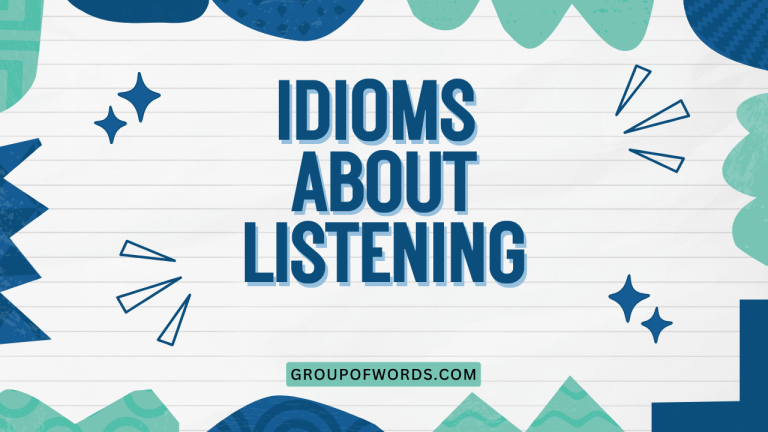Idioms for Teaching: A Comprehensive Guide
Idioms are colorful expressions that add richness and depth to the English language. Understanding and using idioms effectively is crucial for both native speakers and English language learners.
This article provides a comprehensive guide to idioms commonly used in the context of teaching, offering definitions, examples, usage rules, and practice exercises to help you master this fascinating aspect of English grammar. Whether you are a teacher, a student, or simply an English enthusiast, this guide will equip you with the knowledge and skills to confidently navigate the world of idioms in education.
Table of Contents
- Introduction
- Definition of Idioms
- Structural Breakdown
- Types of Idioms
- Examples of Idioms for Teaching
- Usage Rules
- Common Mistakes
- Practice Exercises
- Advanced Topics
- FAQ
- Conclusion
Introduction
Idioms are more than just words; they are windows into a culture, reflecting shared experiences and understandings. In the context of teaching, idioms can be particularly useful for conveying complex ideas in a relatable and memorable way.
This guide explores a variety of idioms that are relevant to the teaching profession, providing context and examples to help you understand their meaning and usage. By mastering these idioms, you can enhance your communication skills and connect with your students on a deeper level.
From describing challenging students to explaining effective teaching strategies, idioms offer a unique and engaging way to express yourself.
Definition of Idioms
An idiom is a phrase or expression whose meaning cannot be understood from the literal meanings of its individual words. Instead, the idiom has a figurative meaning that is known through common usage.
Idioms are often culture-specific and can be challenging for non-native speakers to understand. They add color and expressiveness to language, making communication more engaging and nuanced.
Classification of Idioms
Idioms can be classified based on their structure and meaning. Some common classifications include:
- Phrasal Verbs: These are idioms that consist of a verb and a preposition or adverb (e.g., break down, give up).
- Clichés: These are overused idioms that have become commonplace (e.g., raining cats and dogs, as easy as pie).
- Proverbs: These are short, wise sayings that express a general truth (e.g., actions speak louder than words, a penny saved is a penny earned).
- Metaphorical Idioms: These idioms use metaphors to convey their meaning (e.g., a piece of cake, a drop in the bucket).
Function of Idioms
Idioms serve several important functions in communication. They can:
- Add color and expressiveness to language.
- Convey complex ideas in a concise and memorable way.
- Reflect cultural values and beliefs.
- Enhance communication by making it more engaging and relatable.
Contexts for Using Idioms
Idioms are commonly used in various contexts, including:
- Everyday conversations.
- Literature and poetry.
- Speeches and presentations.
- Teaching and education.
- Business and professional communication.
Structural Breakdown
Understanding the structure of idioms can help you better comprehend their meaning and usage. Idioms often consist of several components, including verbs, nouns, adjectives, and prepositions.
The arrangement of these components is crucial to the idiom’s meaning.
Verbal Idioms
Verbal idioms are those that contain a verb as a key component. These idioms often describe actions or states of being in a figurative way.
For example, “hit the books” means “to study hard,” where “hit” is the verb, but the phrase does not literally mean striking books.
Nominal Idioms
Nominal idioms are those that contain a noun as a key component. These idioms often refer to people, places, or things in a figurative way.
For instance, “a piece of cake” refers to something easy, where “cake” is the noun, but the phrase has nothing to do with actual cake.
Adjectival Idioms
Adjectival idioms are those that function as adjectives, describing nouns in a figurative way. An example is “dirt cheap,” which means very inexpensive, where “dirt” is a noun used to describe the price.
Prepositional Idioms
Prepositional idioms are those that rely heavily on prepositions to convey their meaning. These idioms often describe relationships or locations in a figurative way.
For example, “over the moon” means extremely happy, where “over” is the preposition.
Types of Idioms
Idioms can be categorized based on their thematic content or grammatical structure. Understanding these categories can help you recognize and use idioms more effectively.
Idioms Related to Teaching Methods
These idioms describe different approaches and techniques used in teaching. They can be used to discuss effective or ineffective teaching strategies.
Idioms Related to Student Behavior
These idioms describe the way students act and perform in the classroom. They can be used to discuss student engagement, motivation, and challenges.
Idioms Related to Classroom Environment
These idioms describe the atmosphere and dynamics of the classroom. They can be used to discuss the overall learning environment and its impact on students.
Idioms Related to Academic Performance
These idioms describe students’ success or failure in their studies. They can be used to discuss grades, test scores, and overall academic achievement.
Examples of Idioms for Teaching
Here are several examples of idioms commonly used in the context of teaching, categorized for clarity. Each table provides the idiom, its meaning, and example sentences to illustrate its usage.
Idioms Related to Teaching Methods
This table provides examples of idioms that describe different teaching methods, their meanings, and example sentences.
| Idiom | Meaning | Example Sentence |
|---|---|---|
| Learn by heart | Memorize something perfectly | The students had to learn the poem by heart for the recitation. |
| Teach someone a lesson | Punish or reprimand someone to correct their behavior | The teacher taught the student a lesson about plagiarism by giving him a zero on the assignment. |
| Cut to the chase | Get to the point quickly | Let’s cut to the chase and discuss the main objectives of the lesson. |
| Go the extra mile | Do more than what is expected | A good teacher will always go the extra mile to help their students succeed. |
| Think outside the box | To think creatively and unconventionally | To solve this problem, we need to think outside the box. |
| Get your feet wet | To begin an activity or task for the first time | The new teacher is getting her feet wet by observing experienced teachers. |
| Hit the books | To study hard | I need to hit the books if I want to pass this exam. |
| Burn the midnight oil | To work or study late into the night | The students were burning the midnight oil to finish their research papers. |
| Read between the lines | To understand the hidden meaning | You have to read between the lines to understand what the author is really saying. |
| Paint with a broad brush | To describe something in general terms without specific details | The lecturer painted with a broad brush when discussing the historical period. |
| Take someone under your wing | To mentor or guide someone | The experienced teacher took the new teacher under her wing. |
| Lay the foundation | To establish a basic understanding | The first lesson will lay the foundation for the rest of the course. |
| Learn the ropes | To learn how to do something | It takes time to learn the ropes of teaching. |
| Get the hang of it | To understand how to do something | After a few tries, the student got the hang of the new math concept. |
| Stay on track | To remain focused on the task at hand | It’s important to stay on track during the exam. |
| Miss the mark | To fail to achieve the intended goal | The presentation missed the mark because it was too technical for the audience. |
| Pass with flying colors | To pass with a high score | She passed the exam with flying colors. |
| In the same boat | In the same difficult situation | All the students are in the same boat when it comes to understanding this complex topic. |
| Give a heads up | To give advance notice | The teacher gave the students a heads up about the upcoming test. |
| On the same page | In agreement or understanding | Let’s make sure we’re all on the same page before we start the project. |
| Touch base | To make contact for a brief update | We should touch base next week to discuss the progress. |
| Call the shots | To make the decisions | The principal calls the shots when it comes to school policies. |
| Take the bull by the horns | To face a difficult situation directly | The teacher decided to take the bull by the horns and address the classroom discipline issues. |
| Keep your eye on the ball | To stay focused | It’s important to keep your eye on the ball during the lesson. |
| Think on your feet | To make quick decisions | Teachers often have to think on their feet in the classroom. |
Idioms Related to Student Behavior
This table provides examples of idioms that describe different student behaviors, their meanings, and example sentences.
| Idiom | Meaning | Example Sentence |
|---|---|---|
| Eager beaver | An enthusiastic and hardworking person | She’s such an eager beaver; she always finishes her work early. |
| Class clown | Someone who constantly jokes around in class | The teacher had to reprimand the class clown for disrupting the lesson. |
| Teacher’s pet | A student who is favored by the teacher | He was the teacher’s pet because he always did his homework and participated in class. |
| Copycat | Someone who imitates others | The teacher caught the student being a copycat during the test. |
| Know-it-all | Someone who acts as if they know everything | No one likes a know-it-all in the group projects. |
| Act up | Behave badly | The students started to act up when the teacher left the room. |
| Cut class | Skip class without permission | He decided to cut class and go to the beach instead. |
| Skate by | Get by with minimal effort | He tried to skate by in the course, but he eventually had to put in some work. |
| Slack off | Reduce effort | The students started to slack off towards the end of the semester. |
| Bone up on | Study hard for a specific purpose | I need to bone up on my history before the exam. |
| Draw a blank | Unable to remember something | I drew a blank when the teacher asked me the question. |
| Ace a test | Get a perfect score on a test | She aced the test because she studied hard. |
| Flunk a test | Fail a test | He flunked the test because he didn’t study at all. |
| Get a grip | To control one’s emotions | The student needed to get a grip before presenting his project. |
| Hit the nail on the head | To be exactly right | The student hit the nail on the head with her answer to the question. |
| In over their head | To be in a situation that is too difficult to handle | The student was in over his head when he signed up for the advanced class. |
| Keep up with | To stay at the same level as others | It’s hard to keep up with the fast-paced lectures. |
| Learn the hard way | To learn from difficult experiences | He learned the hard way that procrastination is not a good strategy. |
| Miss the boat | To miss an opportunity | He missed the boat by not submitting his application on time. |
| On the ball | Alert and competent | The student was on the ball during the presentation. |
| Pull an all-nighter | Study or work all night | The student had to pull an all-nighter to finish the assignment. |
| Rock the boat | Cause trouble or disruption | The student didn’t want to rock the boat by questioning the teacher’s methods. |
| Take the easy way out | Choose the simplest solution, even if it’s not the best | He decided to take the easy way out and copy his friend’s homework. |
| Under the weather | Feeling ill | The student was under the weather and couldn’t come to school. |
| Zone out | To stop paying attention | The student started to zone out during the boring lecture. |
Idioms Related to Classroom Environment
This table provides examples of idioms that describe classroom environments, their meanings, and example sentences.
| Idiom | Meaning | Example Sentence |
|---|---|---|
| A breath of fresh air | Something new and refreshing | The new teaching method was a breath of fresh air for the students. |
| A mixed bag | A collection of different things, some good and some bad | The students in the class were a mixed bag, with varying levels of ability and motivation. |
| An uphill battle | A difficult struggle | Trying to teach the students who are not interested is an uphill battle. |
| Calm before the storm | A period of peace before a period of chaos | The quiet classroom was the calm before the storm when the students returned from recess. |
| Get off on the wrong foot | Start a relationship badly | The teacher and the student got off on the wrong foot because of a misunderstanding. |
| Clear the air | To resolve a misunderstanding or conflict | The teacher tried to clear the air after the argument between the students. |
| Keep at bay | To keep something away or under control | The teacher tried to keep distractions at bay during the exam. |
| Level playing field | A situation where everyone has an equal chance | The teacher tried to create a level playing field for all the students. |
| Open a can of worms | Create a complicated problem | The teacher opened a can of worms by addressing the issue of cheating. |
| Put heads together | To work together to solve a problem | The students put their heads together to complete the group project. |
| Set the stage | Prepare for something to happen | The teacher set the stage for the lesson by reviewing the previous material. |
| Smooth sailing | Easy and without problems | Once the students understood the concept, it was smooth sailing for the rest of the lesson. |
| Take its toll | Have a negative effect | The stress of teaching can take its toll on teachers’ health. |
| Turn over a new leaf | To start behaving in a better way | The student decided to turn over a new leaf and start studying harder. |
| Walking on eggshells | Being very careful not to offend someone | The students were walking on eggshells around the strict teacher. |
| Water under the bridge | Something that is in the past and not important anymore | The argument was water under the bridge, and the students moved on. |
| At the top of the class | The best in the class | She is at the top of the class in mathematics. |
| Behind the curve | Lacking knowledge compared to others | The student was behind the curve in science, so he needed extra help. |
| Out of the woods | Out of danger or difficulty | Once the students finished the project, they were out of the woods. |
| Call it a day | To stop working on something | After hours of studying, the students decided to call it a day. |
| Get something off your chest | To express your feelings | The student needed to get something off his chest, so he talked to the teacher. |
| Make waves | Cause trouble | The student didn’t want to make waves by questioning the teacher’s decision. |
| On thin ice | In a precarious situation | The student was on thin ice after skipping several classes. |
| Pull strings | Use influence to get something done | The teacher had to pull strings to get the funding for the project. |
| Rule of thumb | A general principle | As a rule of thumb, students should allocate sufficient time for studying. |
Idioms Related to Academic Performance
This table provides examples of idioms that describe academic performance, their meanings, and example sentences.
| Idiom | Meaning | Example Sentence |
|---|---|---|
| Ace a test | Get a perfect score on a test | She studied hard and managed to ace the test. |
| Flunk a test | Fail a test | He didn’t study and ended up flunking the test. |
| Pass with flying colors | Pass with a high score | She passed the exam with flying colors, earning the highest grade in the class. |
| Skate by | Get by with minimal effort | He tried to skate by without studying, but it didn’t work. |
| Bone up on | Study hard for a specific purpose | I need to bone up on my history before the final exam. |
| Know something inside out | Know something very well | She knows the subject inside out, which is why she’s doing so well. |
| Learn something by heart | Memorize something perfectly | The students had to learn the poem by heart for the recitation. |
| Get the hang of something | Understand how to do something | It took a while, but she finally got the hang of the new software. |
| Draw a blank | Unable to remember something | I drew a blank when the teacher asked me about the capital of France. |
| Hit the books | Study hard | I need to hit the books tonight if I want to pass the exam. |
| Burn the midnight oil | Study or work late into the night | The students were burning the midnight oil to finish their research papers. |
| Read between the lines | Understand the hidden meaning | You have to read between the lines to understand the author’s true intentions. |
| Miss the mark | Fail to achieve the intended goal | The presentation missed the mark because it was too technical for the audience. |
| On the right track | Making progress in the right direction | The student is on the right track with her research project. |
| Behind the eight ball | In a difficult situation | The student was behind the eight ball after missing several classes. |
| Come out on top | Succeed despite difficulties | Despite the challenges, she managed to come out on top and graduate with honors. |
| Cut the mustard | To succeed or meet expectations | He needs to improve his grades if he wants to cut the mustard in this course. |
| Get a head start | Start something early to gain an advantage | The students who started studying early got a head start on the exam. |
| In the bag | Assured of success | Once she finished her research, the project was in the bag. |
| Keep your eye on the prize | Stay focused on your goal | It’s important to keep your eye on the prize and not get distracted by setbacks. |
| Make the grade | Meet the required standard | He worked hard to make the grade and pass the course. |
| Not up to par | Not good enough | His performance on the last test was not up to par. |
| Over the hump | Past the most difficult part | Once they finished the research phase, they were over the hump. |
| Pass the buck | Avoid responsibility by passing it on to someone else | The teacher refused to pass the buck and took responsibility for the students’ performance. |
| Raise the bar | To set higher standards | The teacher decided to raise the bar to challenge the students. |
| Take the plunge | To do something difficult or risky | The student decided to take the plunge and present her research at the conference. |
Usage Rules
Using idioms correctly requires understanding their specific meanings and contexts. Idioms should be used appropriately to avoid confusion or miscommunication.
Here are some key usage rules to keep in mind.
Contextual Appropriateness
Ensure that the idiom is appropriate for the context and audience. Avoid using idioms in formal writing or when communicating with someone who may not be familiar with them.
Consider your audience and the formality of the situation before using an idiom. In academic writing, it’s generally best to avoid idioms unless they are used to illustrate a point in a clear and concise manner.
Grammatical Structure
Maintain the correct grammatical structure of the idiom. Do not change the word order or substitute words, as this can alter the meaning or make the idiom nonsensical.
For example, “hit the books” should not be changed to “strike the books,” as the latter does not convey the same meaning.
Literal vs. Figurative Meaning
Be aware of the difference between the literal and figurative meanings of the idiom. Remember that idioms are not meant to be taken literally.
Understanding the figurative meaning is crucial for using the idiom correctly. For example, “break a leg” does not literally mean to break someone’s leg; it means “good luck.”
Avoid Overuse
Avoid overusing idioms in your writing or speech. While idioms can add color and expressiveness to language, using too many can make your communication sound unnatural or forced.
Use idioms sparingly and strategically to enhance your message.
Cultural Sensitivity
Be mindful of cultural differences when using idioms. Some idioms may not be understood or may be offensive in certain cultures.
Research the idiom’s cultural origins and connotations before using it, especially when communicating with people from different backgrounds.
Common Mistakes
Learners often make common mistakes when using idioms. Being aware of these mistakes can help you avoid them and use idioms more accurately.
Literal Interpretation
One of the most common mistakes is interpreting idioms literally. Remember that idioms have a figurative meaning that is different from the literal meaning of the words.
For example:
- Incorrect: “The teacher said to break a leg, so I should go to the hospital.”
- Correct: “The teacher said to break a leg, meaning she wished me good luck.”
Incorrect Word Order
Changing the word order of an idiom can alter its meaning or make it nonsensical. For example:
- Incorrect: “Hit the books I must.”
- Correct: “I must hit the books.”
Wrong Preposition
Using the wrong preposition in an idiom can change its meaning. For example:
- Incorrect: “I am over the moon with happiness.”
- Correct: “I am over the moon.”
Substitution of Words
Substituting words in an idiom can change its meaning or make it nonsensical. For example:
- Incorrect: “A slice of cake.”
- Correct: “A piece of cake.”
Overuse
Using too many idioms in a short span can make your writing or speech sound unnatural or forced. For example:
- Incorrect: “I was burning the midnight oil to hit the books and ace the test. It was a piece of cake, but I had to go the extra mile.”
- Correct: “I studied hard late into the night to prepare for the test.”
Practice Exercises
Test your understanding of idioms with these practice exercises. Each exercise includes a series of questions and answers to help you reinforce your knowledge.
Exercise 1: Fill in the Blanks
Complete the following sentences with the correct idiom from the list below.
(a piece of cake, hit the books, cut to the chase, think outside the box, learn by heart)
| Question | Answer |
|---|---|
| 1. The exam was _____, so I finished it quickly. | a piece of cake |
| 2. I need to _____ if I want to pass the test. | hit the books |
| 3. Let’s _____ and discuss the main points of the lesson. | cut to the chase |
| 4. To solve this problem, we need to _____. | think outside the box |
| 5. The students had to _____ the poem for the recitation. | learn by heart |
| 6. The teacher asked the students to _____ the new vocabulary words. | Learn by heart |
| 7. Since we’re short on time, let’s just _____ and get started. | Cut to the chase |
| 8. This assignment is _____, so don’t worry about it too much. | a piece of cake |
| 9. If you want to succeed, you need to _____ and put in the effort. | Hit the books |
| 10. To come up with innovative solutions, we need to _____. | Think outside the box |
Exercise 2: Multiple Choice
Choose the correct meaning of the idiom in each sentence.
| Question | Options | Answer |
|---|---|---|
| 1. The teacher told the student to get his act together. | (a) improve his behavior (b) perform on stage (c) write a play | (a) improve his behavior |
| 2. The students were burning the midnight oil to finish their projects. | (a) setting fires (b) working late (c) wasting time | (b) working late |
| 3. The teacher decided to take the bull by the horns and address the discipline issues. | (a) run away from the problem (b) ignore the problem (c) face the problem directly | (c) face the problem directly |
| 4. The new teaching method was a breath of fresh air for the students. | (a) polluted air (b) something new and refreshing (c) a storm | (b) something new and refreshing |
| 5. The student was on thin ice after skipping several classes. | (a) safe (b) in a dangerous situation (c) having fun | (b) in a dangerous situation |
| 6. After a difficult start, the class finally got the hang of the new concept. | (a) lost interest (b) became confused (c) understood how to do it | (c) understood how to do it |
| 7. The teacher had to pull strings to get the funding for the project. | (a) play music (b) use influence (c) tie knots | (b) use influence |
| 8. He tried to skate by in the course, but he eventually had to put in some work. | (a) excel effortlessly (b) get by with minimal effort (c) fail spectacularly |
(b) get by with minimal effort |
Advanced Topics
Delve deeper into idioms with these advanced topics that explore their origins, evolution, and cultural significance.
Etymology of Idioms
The etymology of idioms refers to the study of their origins and historical development. Many idioms have fascinating stories behind them, often rooted in historical events, cultural practices, or literary works.
Understanding the etymology of an idiom can provide insight into its meaning and usage. For example, the idiom “raining cats and dogs” is believed to have originated in 16th-century England, where thatched roofs provided shelter for animals, which would sometimes fall during heavy rainstorms.
Regional Variations in Idioms
Idioms can vary significantly from one region to another. What is a common idiom in one part of the world may be completely unknown or have a different meaning in another.
These regional variations reflect the diverse cultural and linguistic landscapes of the English-speaking world. For example, the idiom “the bee’s knees,” meaning excellent or high quality, is primarily used in American English and may not be as common in British English.
Idioms in Literature and Popular Culture
Idioms are frequently used in literature and popular culture to add color, expressiveness, and cultural relevance to the text. Authors and screenwriters often use idioms to create vivid imagery, convey complex emotions, and establish a connection with the audience.
Recognizing and understanding idioms in literature and popular culture can enhance your appreciation and comprehension of the work. For example, Shakespeare’s plays are filled with idioms that were common in Elizabethan England, and modern novels often use idioms to reflect contemporary language and culture.
Teaching Idioms to English Language Learners
Teaching idioms to English Language Learners (ELLs) requires a strategic and patient approach. Idioms can be particularly challenging for ELLs because their meanings are not literal and often culture-specific.
Effective strategies for teaching idioms to ELLs include providing clear definitions, using visual aids, offering contextual examples, and encouraging students to use the idioms in their own writing and speech. It’s also important to be mindful of cultural differences and to select idioms that are relevant and appropriate for the students’ backgrounds.
FAQ
Here are some frequently asked questions about idioms, along with detailed answers to help clarify any confusion.
What is the difference between an idiom and a metaphor?
An idiom is a phrase whose meaning cannot be understood from the literal meanings of its individual words; it has a figurative meaning known through common usage. A metaphor, on the other hand, is a figure of speech that directly compares two unrelated things, highlighting a similarity between them.
While some idioms can be metaphorical, not all metaphors are idioms. Metaphors are more flexible and can be created on the spot, while idioms are fixed expressions.
How can I improve my understanding of idioms?
To improve your understanding of idioms, focus on reading widely, listening to native speakers, and paying attention to the context in which idioms are used. Keep a notebook of new idioms you encounter, along with their definitions and example sentences.
Practice using the idioms in your own writing and speech to reinforce your learning. Additionally, explore resources like idiom dictionaries, online forums, and language learning apps that focus on idioms.
Are idioms the same in all English-speaking countries?
No, idioms can vary significantly between different English-speaking countries. What is a common idiom in one country may be completely unknown or have a different meaning in another.
These regional variations reflect the diverse cultural and linguistic landscapes of the English-speaking world. For example, some idioms are more common in American English, while others are more prevalent in British English, Australian English, or Canadian English.
Is it okay to use idioms in formal writing?
In general, it’s best to avoid using idioms in formal writing unless they are used to illustrate a point in a clear and concise manner. Formal writing typically requires a more direct and precise style, and idioms can sometimes sound informal or colloquial.
However, there may be exceptions depending on the specific context and audience. When in doubt, it’s best to err on the side of caution and use more straightforward language.
How can I teach idioms to English language learners effectively?
To teach idioms effectively to English language learners, start with simple and commonly used idioms. Provide clear definitions and examples in context.
Use visual aids, such as pictures or diagrams, to help students understand the figurative meaning of the idioms. Encourage students to use the idioms in their own writing and speaking.
Be patient and provide plenty of opportunities for practice and review. Also, be mindful of cultural differences and choose idioms that are relevant and appropriate for the students’ backgrounds.
Conclusion
Idioms are an integral part of the English language, adding richness, color, and expressiveness to communication. Mastering idioms can significantly enhance your ability to understand and use English effectively, particularly in the context of teaching.
By understanding the definition, structure, types, usage rules, and common mistakes associated with idioms, you can confidently navigate this fascinating aspect of English grammar. Whether you are a teacher, a student, or simply an English enthusiast, the knowledge and skills gained from this guide will empower you to communicate more effectively and connect with others on a deeper level.
Embrace the challenge of learning idioms, and you will unlock a new dimension of the English language.






